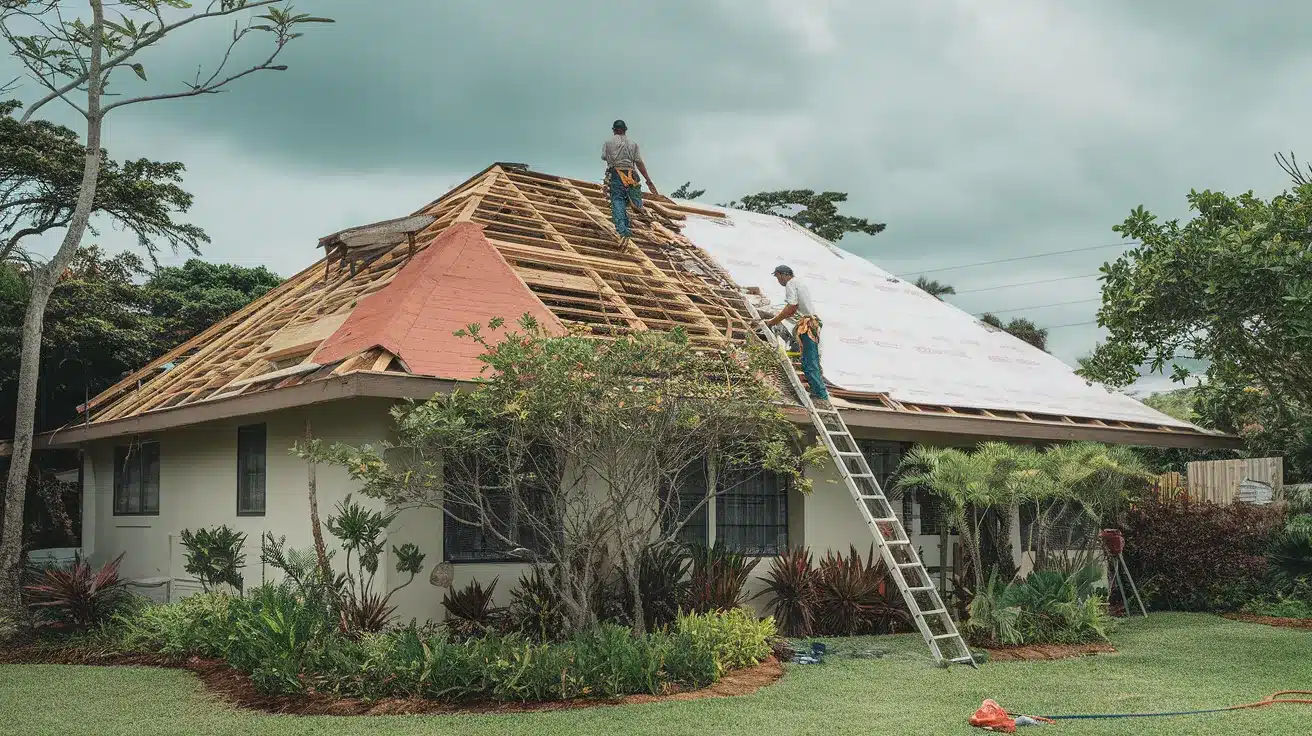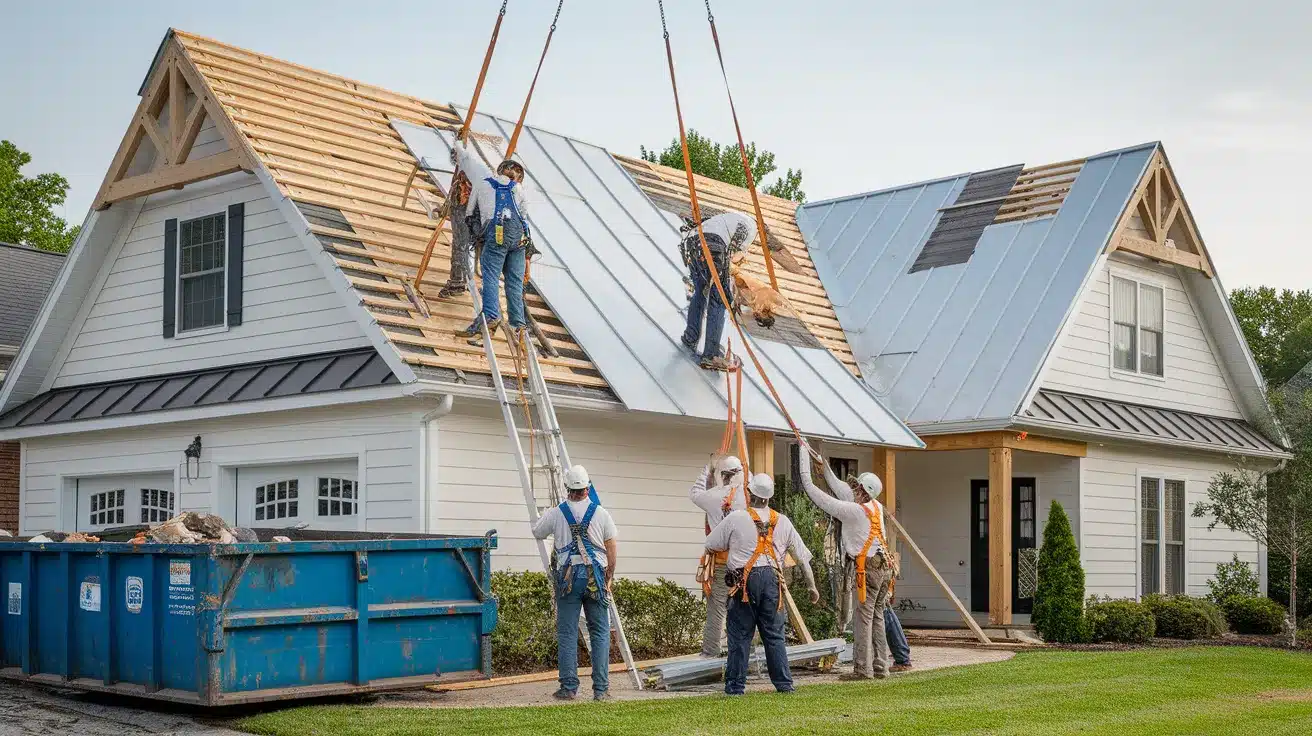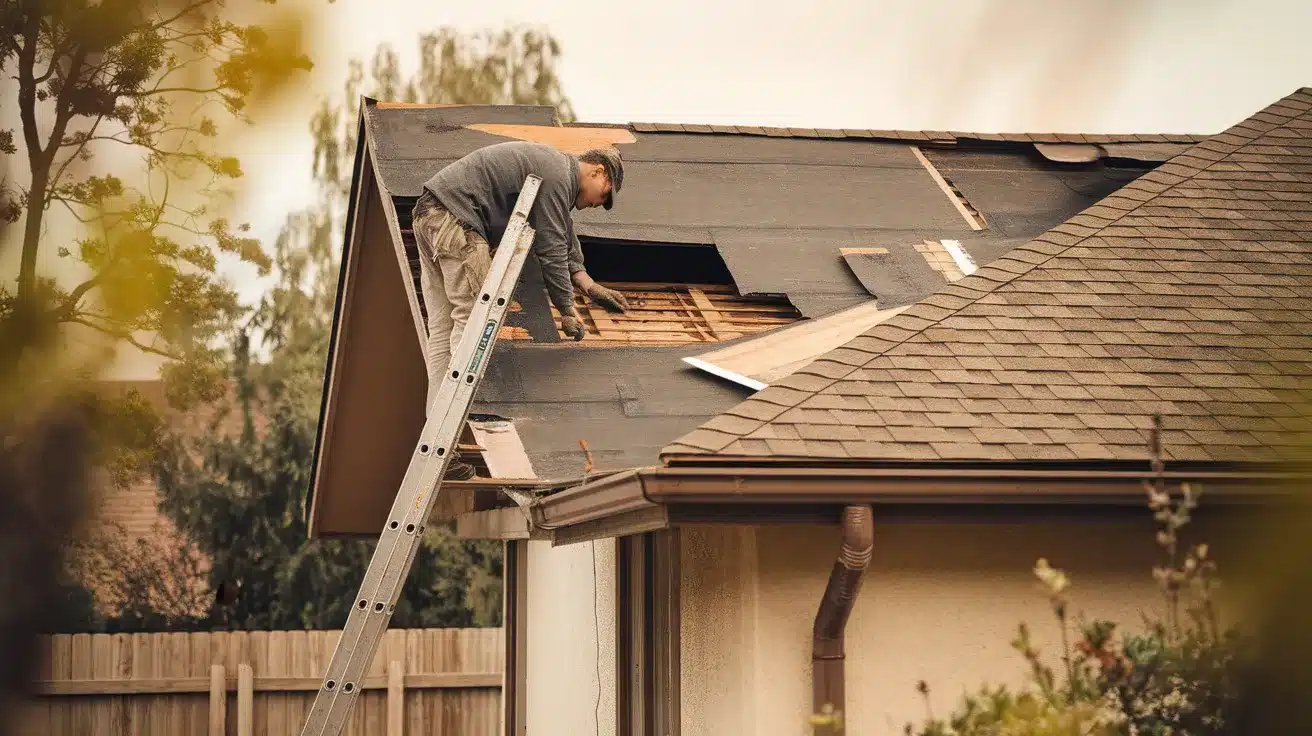Picture this: you wake up to the sound of heavy boots stomping across your ceiling at 7 AM. Hammers are pounding, debris is falling, and strangers are literally tearing apart the thing that keeps rain out of your living room.
Welcome to roof replacement day.
Here’s the million-dollar question every homeowner faces: Should you pack a bag and escape to your sister’s house, or tough it out in your own home? It’s not as simple as you might think.
Some folks swear by staying put to keep an eye on things. Others grab their kids and pets and run for the hills. But here’s what most people don’t realize – your decision could make or break the entire experience.
Can I Stay at Home During a Roof Replacement?
The short answer? Yes, you absolutely can stay home during a roof replacement. But whether you should is a completely different story.
Most roofing contractors are perfectly fine with homeowners staying put during the work. In fact, many prefer it because you’re available to answer questions and make quick decisions. Plus, you can keep an eye on your belongings and ensure everything goes according to plan.
But here’s the reality check. Roof replacement isn’t exactly a quiet afternoon project. We’re talking about serious noise that starts early and lasts all day.
Think constant hammering, power tools, and the lovely sound of old shingles being ripped off and tossed into a dumpster right outside your window.
So, should you stay or go? Here’s the quick decision guide:
| Stay Home If | Leave If |
|---|---|
| You don’t mind construction noise and chaos | You work from home and need quiet for calls |
| You want to monitor the project closely | You have noise sensitivity or get headaches |
| No pets that stress over loud sounds | Your pets freak out over construction noise |
| No young children who nap during the day | You have babies or toddlers needing quiet time |
| You’re curious about the roofing process | You value peace and quiet above all else |
| You can handle disruption to your routine | You have important meetings or deadlines |
The choice really comes down to your personal tolerance level and living situation.
Why Staying Might Not Be the Best Choice for Everyone?
Let’s be honest – roof replacement can turn your peaceful home into a construction zone. Here’s what you’re really signing up for:
• Constant, loud noise from hammering and tearing Starting at 7 AM, you’ll hear non-stop pounding, scraping, and power tools. It’s not background noise – it’s the kind that makes phone calls impossible and gives you a headache by lunch.
• Crew may need indoor attic access Roofers often need to check your attic space for damage or proper ventilation. This means strangers walking through your house, which can feel invasive and disrupt your normal routine.
• Possible debris hazards around the property Nails, shingle pieces, and other materials can scatter around your yard. This creates safety risks, especially if you have kids who play outside or pets that might step on something sharp.
• Pets and kids may become stressed The loud, unfamiliar sounds can send pets into panic mode. Dogs might bark all day, cats could hide and refuse to eat, and young children often get cranky or scared from the constant noise overhead.
• Dust and vibrations throughout the house Your walls will shake, pictures might fall, and dust can filter down from the attic. It’s messier than you’d expect, even when crews are careful.
What to Expect If You Stay?
If you decide to tough it out at home, here’s the reality of what your day will look like. It’s not just background construction noise – we’re talking about a full-scale disruption to your normal routine.
1. Noise Levels & Disruptions
Whether roofers use hand-nailing or air guns, both methods are seriously loud. Hand-nailing might actually be more intense because of the constant rhythmic pounding that seems to echo through your entire house. Don’t think hiding on the first floor will save you from the noise – sound travels through even two-story homes like you wouldn’t believe.
The noise isn’t just annoying, it’s all-consuming. You’ll find yourself shouting to have normal conversations, and forget about watching TV or taking work calls. Even with noise-canceling headphones, you’ll still feel the vibrations through the house structure. Most homeowners are shocked by just how penetrating the sound really is.
2. Consideration for Pets & Children
Your furry friends won’t understand what’s happening, and cats especially tend to get anxious with loud, unfamiliar sounds overhead. Many pet owners find it’s worth arranging pet daycare or asking relatives to watch their animals for the day. Dogs might bark constantly or pace nervously, while cats often disappear under beds and refuse to come out.
Kids might initially find the whole process exciting, but that novelty wears off fast. The constant noise can become overwhelming, especially for younger children who might not understand why their house sounds like it’s falling apart. Plus, there are legitimate safety concerns with little ones around active construction zones where debris and tools are everywhere.
3. Parking & Mobility Constraints
Expect your driveway to be completely taken over by dump trucks, trailers, and crew vehicles. Smart homeowners move their cars the night before to avoid being trapped or having to negotiate around heavy equipment. You’ll want that flexibility in case you need to make emergency runs for supplies or decide you’ve had enough and want to escape for a few hours.
The logistics get tricky when you realize you can’t just pop out for coffee or groceries without planning around the crew’s schedule. Large delivery trucks need space to maneuver, and you don’t want to be the person holding up the entire job because your car is blocking access to materials.
4. Mess and Safety
The tear-off phase is absolute chaos. Despite contractors’ best efforts to contain debris, pieces of old roofing material can end up scattered around your property. Stay well away from gutters and anywhere crews are actively throwing materials down. Even experienced roofers can’t control exactly where every piece lands.
Inside your house, you’ll deal with dust filtering down and vibrations that can knock pictures off walls. Some homeowners are surprised when their smoke detectors go off from all the dust, or when items fall off shelves from the constant hammering. It’s messier and more disruptive than most people expect, even when everyone’s being careful.
What You MUST Do If You Decide to Stay?
If you’re committed to staying home during the roof replacement, you need to take some serious precautions. These aren’t suggestions – they’re essential steps to protect your property and sanity.
Secure Your Home
- Remove wall-hung items and shelf valuables – The constant hammering creates vibrations that travel through your entire house structure. Pictures will fall, decorative items will slide off shelves, and anything breakable needs to come down before work starts.
- Cover furniture and protect flooring – Dust finds its way everywhere, even through closed doors and windows. Use plastic sheeting or old sheets to cover upholstered furniture, and consider protecting hardwood floors in rooms directly below the work area.
- Secure fragile fixtures – Light fixtures, ceiling fans, and hanging plants can shake loose from their mountings. Either remove them temporarily or make sure they’re properly secured to handle the vibrations.
Document Your Property
- Take before photos of your property inside and out – This is your insurance policy against damage disputes. Photograph your landscaping, siding, windows, and any existing exterior damage so there’s no confusion about what was already there.
- Document interior conditions – Take pictures of rooms directly below the work area, including ceilings, walls, and any existing cracks or damage. If something gets worse during the project, you’ll have proof of the original condition.
- Create a digital record with timestamps – Store photos in a cloud service with clear dates. This creates an undisputable record that protects both you and the contractor from false damage claims.
Coordinate with the Crew
- Discuss safety zones and establish boundaries – Make it clear which areas of your property are off-limits and where you need safe passage. Ask about designated debris drop zones so you know where not to walk or park.
- Set communication expectations upfront – Get the crew leader’s direct phone number and establish how they’ll communicate with you about problems, delays, or decisions that need your input during the day.
- Ask about any possible quiet periods – While most roofing work is consistently loud, some crews can time their noisiest tasks around your schedule if you have important calls or meetings planned.
What to Do After Your Roof Replacement is Complete?
The crew has packed up and left, but your job isn’t quite done yet. Here’s how to properly wrap up your roofing project and protect your investment.
1. Walk around your property for a thorough cleanup inspection. Even the most careful crews can miss small debris. Check your gutters, walkways, and landscaping for stray nails, shingle pieces, or wrapper materials that could damage lawnmowers or hurt bare feet.
2. Schedule a final walkthrough with your contractor before they leave. Don’t just wave goodbye from the window. Do a complete inspection together while they’re still on-site. This is your chance to address any concerns or touch-ups before the final payment.
3. Take comprehensive after photos for your records. Document the completed work from all angles, including close-ups of flashing, gutters, and any special details. These photos are valuable for warranty claims and future maintenance planning.
4. Test your gutters and downspouts with a garden hose. Run water through the system to make sure everything flows properly and there are no leaks at the connections. It’s easier to fix issues now than during the next rainstorm.
5. Keep all warranty paperwork and contractor contact information handy. File away your contract, warranty details, and the crew leader’s contact info in a safe place. You’ll thank yourself later if you need to call about warranty work or have questions about maintenance.
Bottom Line
So, should you stay home during your roof replacement? The honest answer is – it depends entirely on you.
If you’re the type who can handle chaos, don’t mind feeling like you’re living inside a drum, and want to keep a close eye on your investment, then staying put might work fine.
But if you value your peace of mind, work from home, or have pets and kids to consider, it’s probably worth finding somewhere else to spend the day.
Remember, this isn’t a decision you have to make and stick with forever. You can always start the day at home and bail out if it becomes too much.
Many homeowners end up doing exactly that – and there’s absolutely nothing wrong with admitting defeat and heading to your favorite coffee shop.
Your roof replacement is a big deal, but your sanity matters too.





